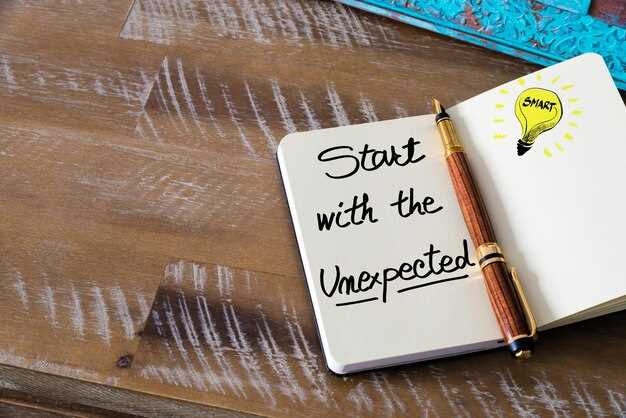Recommendation: Set one measurable goal for the next 30 days: commit 20–30 minutes each morning to a single task (writing, planning, or a focused project), log completion in a simple spreadsheet, and review totals weekly; this habit converts scattered projects into reliable progress and makes long-term objectives easier to reach. Progress begins with the first measurable day and a clear metric used to evaluate it.
If you are unable to dedicate a full block, use three lightweight alternatives: a 10‑minute audio note, a single photograph with a caption, or a two‑item checklist. For instance, a parent having dinner duties can record a 5‑minute voice memo while the family settles; extraverted people often use small groups for accountability, while quiet people prefer a private log. Choose a place and a method that keeps distracting outside influences away and prevents negative feelings from derailing consistency.
Measure outcomes: Track days completed, minutes spent, and one qualitative rating of happiness; aim for ≥70% completion over 90 days rather than perfection. Many who hit that threshold reported feeling closer to their values and that their choices reflected how they had lived, not how others perceived them. Think in micro‑goals, make weekly retrospectives nonnegotiable, and apply the same routine to community or creative projects so responsibilities you used to touch become ones you actively manage.
Five Practical Strategies to Build Deep Relationships
Schedule a weekly 60-minute focused session with one person: set two 25-minute turns on a visible timer, one topic each turn, and finish with three action items; this predictable time reduces the tendency to interrupt, youll accelerate trust, and youll know within weeks if the rhythm is helpful.
Share one short personal disclosure per month: limit it to 90 seconds, avoid explanations or defenses, and dont expect reciprocation immediately; instead ask whats most meaningful about the moment–this signals empathy, clarifies needs, and makes the other person feels heard and loved.
Launch a 3–6 month joint project to test collaboration: pick a creative task (a small community event, a photo zine, or a weekend hack), define weekly deliverables, and rotate leadership; projects draw out conflict styles, reveal social skills, and create reliable data from which to judge compatibility and possibilities.
Use technology to free up presence: mute group threads, use one free scheduling app for meetups, and limit video check-ins to 30 minutes twice monthly; relationship researchers and experts who have followed couples for years suggests synchronous face time is the strongest factor in emotional closeness–technology would support coordination, not replace it.
Apply a simple reciprocity strategy: review the last five interactions, mark whether support was offered, and if supportive moves are fewer than two, name the pattern and propose one adjustment; there are clear reasons one-sided patterns persist, and this method helps you know when to invest more or step back.
Pick two relationships to prioritize and plan a weekly 20‑minute check-in
Choose two people–one who improves your immediate social support and one who brings outside perspective–and lock a recurring 20 minutes slot each week (same weekday and time); making it a fixed appointment makes consistency easier and creates a clear baseline for change.
Structure the 20 minutes: 0–2 minutes quick greeting and context, 3–7 minutes wellbeing check (stress level 1–10, sleep, mood), 8–14 minutes updates on one project or interest and recent wins/challenges, 15–18 minutes concrete needs or offers of help, 19–20 minutes confirm next action and time. Use a short shared list (digital note or paper) to record date, perceived closeness 1–10, one action item and one trait you admired that week.
Use listening tactics: ask one open question, mirror language for 10–15 seconds, dont interrupt, reflect back one sentence, and end with a specific check (Would you like feedback or space?). Creative prompts for months when conversation stalls: swap a favourite article, share a micro‑project idea, or name a small habit youre trying. These prompts reduce friction and increase willingness to share.
Track outcomes every eight to twelve months: measure trend in confidence, perceived support, and time spent together; note whether social influence from these two people changes decisions or mood. An example metric: +0.5 points per month on closeness equals measurable improvement in well‑being. If closeness scores fall, rotate one prioritized person after three months. This plan gives youll a repeatable system for deeper connection within limited time while keeping priorities clear.
Turn conflict into curiosity: three questions to ask before reacting
Pause six seconds and ask three precise questions before replying: “What did they mean?”, “What need is behind this?”, “What small test can I try now?”
-
Question 1 – “What did they actually say or mean?”
- Exact phrasing to use silently or aloud: “Help me understand what you mean by that.”
- Why: wording errors, tone, or facial microexpressions often change meaning; Paul Ekman research shows emotion signals can be misread, so assume ambiguity rather than blame.
- Quick test: repeat a concise, neutral summary (10–12 words) and ask for confirmation. Example: “You’re upset about the budget cut–am I close?”
- Timing: 3–12 seconds to pause, 5–10 seconds to summarize, then listen. If youve practiced this habit, youll notice fewer escalations.
-
Question 2 – “What need, value or reason is driving them?”
- Probe for motives without accusing: “What are you trying to protect or reach here?”
- Data point: people who frame motives report more honest disclosures and more shared solutions; the factor of perceived threat predicts reactive tone more than content.
- Examples of hidden drivers: fear of being judged, loyalty to friends, concern about fairness, or deep values (even afterlife beliefs or cultural norms) that seem unrelated on the surface.
- Use language that names needs: “It sounds like you want trust/clarity/recognition.” This reduces the tendency to project and invites real reasons to surface.
-
Question 3 – “What small, reversible experiment can I try now?”
- Options: give more information, offer a brief apology for part you own, ask to pause and reconvene, or propose a trial change for one week.
- Guideline: choose a small response–no more than one sentence and 10 seconds–so you remain free to adjust after feedback.
- Sample scripts: “Can we test this next week and see if it feels better?” or “I’ll try giving clearer timelines for two projects; will that help?”
- Measure: try three micro-experiments across a month and note which reduces heated exchanges; share results with a trusted colleague or friends.
Practice plan and metrics:
- Daily habit: three pauses per reactive trigger for 14 days. Record each event and label whether the pause led to more honest exchange.
- Goal: reduce automatic defensive replies by 60% within one month and increase mutually useful outcomes in conflicts by 30% (track with simple yes/no after-conversation notes).
- Roleplay: during summer or any slow period, run 10-minute drills with someone near you; alternate being the upset party and the curious responder.
- Self-monitoring: note fluctuations in confidence and comfort–if youre unable to pause, identify the physiological cue (heart rate, tight chest) and train a calming micro-habit (three slow breaths).
Why this works:
- Curiosity shifts the dynamic from attack/defense to information-seeking; they feel heard and you gain data, which leads to better decisions.
- Small responses lower emotional stakes and create shared agency; parallels exist with scientific testing: make a small hypothesis, run a quick trial, adjust.
- Social proof: people who practice these habits report more meaningful and joyful connections and greater confidence in conflict settings.
Final note: if someone continues to project hostility after repeated curious attempts, document specifics, set clear boundaries, and consult a neutral third party or mediator; dont leave important issues unresolved because youre comfy avoiding tension.
Further reading and research summaries: https://greatergood.berkeley.edu/
Start a small shared project: step‑by‑step plan to collaborate
Commit to a single micro-project: one clear deliverable, six weeks, and a 60‑minute kickoff scheduled within 72 hours; invite 3–6 people so the group stays social but manageable.
Define scope in writing: list the deliverable, two success metrics, weekly time expectations, and which needs each participant will cover; make roles explicit so nobody assumes tasks while others are working.
Run a tight kickoff agenda: 10 minutes of purpose, 20 minutes of task assignment, 20 minutes of scheduling and blockers. Ask each person to tell one constraint and one personal goal – this shows commitments and feelings, not just plans.
Use simple tools: shared notes, one lightweight task board, and asynchronous voice notes if mobility or novelty matters; choose technology that everyone can access free and test it during the kickoff so youve no friction later.
Design small interactions to increase warmth: pair an extraverted volunteer with a reserved member for a 30‑minute check‑in; arrange one in‑person walk in the woods or a bench meetup in fall to surface non‑task rapport without formalities.
| Settimana | Main activity | Expected output |
|---|---|---|
| 0–1 | Kickoff, role assignment | One shared doc that describes deliverable and timelines |
| 2–3 | Focused production sprints | First prototype or draft; little experiments for novelty |
| 4 | Midpoint review | List of fixes and parallels to prior work |
| 5 | Polish and testing | Final draft, QA notes |
| 6 | Delivery and retrospective | Final asset and clear reasons for next actions |
Assign one person as timekeeper and another as editor; then rotate those roles each project so more people gain skills. Write decision points into the shared doc with timestamps so later discussions are traceable.
When blockers appear, ask two practical questions: what do you need to proceed, and who can give that resource within 48 hours? If the answer is nobody, pause the subtask and reassign; this prevents small delays from growing.
At delivery, run a 30‑minute retrospective that begins with three positives, then one improvement; ask participants to wear a one‑word summary of feelings (typed into chat) – this quick ritual makes feedback concrete and shows psychological safety.
After the project, publish a one‑page postmortem that describes outcomes and parallels to other work, list three reasons the group did better or worse than expected, and offer the artifact free to interested contacts so the group gains visibility and more collaborators.
Keep iteration cheap: plan no more than two new features after delivery; if youve momentum, decide which of them to prototype next, otherwise close the project and archive materials in a common place to reuse later.
Measure impact with two simple measures: one usage metric and one qualitative quote that shows how the deliverable meets real needs; this makes a tiny project feel more meaningful and helps people want to live more connected work in future collaborations.
Set one recurring micro‑ritual to signal commitment and predictability
Choose one 3–5 minute micro‑ritual and perform it at the same clock time every day; pick a time you can defend for months (example: 07:15). Use a single thing as the cue (arrival at desk, closing laptop, finishing dinner) and one repeatable action (breath pattern, two‑sentence mantra, 30‑second stretch). paul uses a 4‑minute routine: say his name aloud, inhale for 4 counts, exhale for 6, then write a single sentence.
Measure what matters: log what you did, what time, how many words you wrote and any immediate feelings. Use a free habit app connected with your internet calendar or a simple CSV. Export after 30, 60 and 90 days, then compare focused hours versus distracted hours; a 5% reduction in micro‑distractions can equal 12–20 extra focused hours across three months.
When sharing results with another person, state one reason and one data point rather than vague claims; if friends suggest tweaks, test the change for two weeks. Give yourself different options for travel or illness so you don’t quit – do not expect the ritual to work always the same way. Draw a baseline for wellbeing on a 1–10 scale and remeasure monthly; those numbers reveal whether the ritual influences pursuit of larger goals over a lifetime. If nothing else, the practice makes you more sure about what matters in that instance and reduces small workflow bugs.
Psychological Tools to Create a Happier, More Meaningful Life
Keep a daily gratitude log: each morning write three specific positive experiences you noticed yesterday and one honest action you will take today; record your baseline mood on a 0–10 scale and repeat weekly – meta-analyses suggest small-to-moderate gains in positive affect after 8–12 weeks and continued improvement across months.
Use behavioral activation: schedule two short projects per week (one creative, one practical) and one 20–30 minute walk outside three times weekly; for an introvert, a practical social strategy is a 10-minute focused conversation with warmth and empathy rather than multiple surface interactions – they report less drain and more happy connection.
Apply cognitive reappraisal in situations where negative interpretation dominates: pause 90 seconds, write the automatic thought, list two alternative explanations, then note the new feeling; randomized trials used this protocol and show reduced negative feeling and more peace within weeks. Experts suggest practicing this 3× daily during stressful months and combining it with brief paced breathing (4s inhale, 6s exhale) for long-term benefit.
Design boundary experiments: choose one relationship or task to leave alone for two weeks and record changes in mood and energy; be sure to include acts of kindness twice weekly (small, honest gestures) – data suggests kind acts boost positive affect more when paired with reflection. Example tracking sheet: date, context, action, mood pre/post, notes on personality fit; adjust every month based on what most predicts steady gains.


 How to Live a Meaningful Life – Proven Secrets, Tips & Actionable Steps">
How to Live a Meaningful Life – Proven Secrets, Tips & Actionable Steps">


 Come Comunicare con Amore Quando Sei Arrabbiato — Consigli Calmi">
Come Comunicare con Amore Quando Sei Arrabbiato — Consigli Calmi">
 Signs of Emotional Disconnection in Relationships — How to Recognize a Lack of Emotional Connection">
Signs of Emotional Disconnection in Relationships — How to Recognize a Lack of Emotional Connection">
 Signs of a Lack of Emotional Connection in a Relationship">
Signs of a Lack of Emotional Connection in a Relationship">
 Too Busy to Date? Find Time & Energy with 10 Easy Tips">
Too Busy to Date? Find Time & Energy with 10 Easy Tips">
 Vivian Baruch – Biography, Net Worth, Career & Latest News">
Vivian Baruch – Biography, Net Worth, Career & Latest News">
 How to Reignite the Spark in Your Long-Term Relationship – 5 Research-Backed Rituals">
How to Reignite the Spark in Your Long-Term Relationship – 5 Research-Backed Rituals">
 Cosa Fare Se il Tuo Partner È Amico di un Ex e Non Ti Piace — Episodio Podcast 186">
Cosa Fare Se il Tuo Partner È Amico di un Ex e Non Ti Piace — Episodio Podcast 186">
 25 Idee per Serate Romantiche a Casa Migliori di Netflix">
25 Idee per Serate Romantiche a Casa Migliori di Netflix">
 Consigli di Incontri per Donne Over 50 – Fiducia e Successo">
Consigli di Incontri per Donne Over 50 – Fiducia e Successo">
 Il matrimonio sta morendo o cambiando? Tendenze, cause e futuro">
Il matrimonio sta morendo o cambiando? Tendenze, cause e futuro">